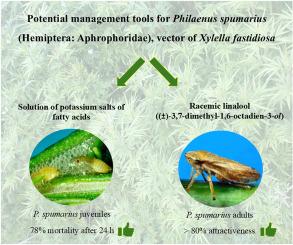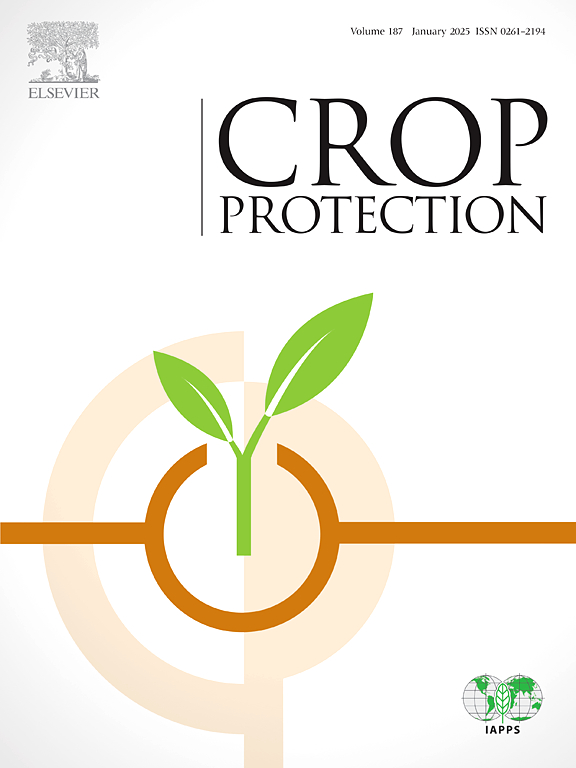Soft soap and linalool as potential management tools for Philaenus spumarius (Hemiptera: Aphrophoridae), vector of Xylella fastidiosa
IF 2.5
2区 农林科学
Q1 AGRONOMY
引用次数: 0
Abstract
Philaenus spumarius (Hemiptera: Aphrophoridae) is one of the most polyphagous xylem-feeding pests. It recently acquired bad fame when it was identified as the main vector of the bacterium Xylella fastidiosa, the causal agent of the Olive Quick Decline Syndrome that, within ten years, has affected and led to the death of more than 21 million olive trees in the Southern Italian region Apulia alone. Despite the agricultural practices and synthetic insecticides available, as not sufficiently effective, more strategies to target all the developmental instars of the pest and eco-friendly formulations, especially in organic orchards, are urgently needed. Therefore, the main goals of this work were to test the toxicity of a solution of potassium salts of fatty acids (soft soap) on P. spumarius juveniles and assess the attractiveness exerted by linalool on adults in a planar olfactometer. According to our results, the average neanids/nymphs’ mortality was 82.2 ± 10.4% 24h after spraying the soft soap on them at the labelled dose. Regarding the adults, linalool was significantly attractive to both sexes in a concentrations range between 0.01 and 0.12 μL linalool L−1 air. Our purpose is to potentially suggest a dual, integrated control approach against P. spumarius, with the soft soap as a biopesticide to reduce the immature stages of the pest and attractive, linalool-activated traps to numerically cull the population of the meadow spittlebug as part of a broader management system.

软肥皂和芳樟醇作为潜在的管理工具,可用于防治 Xylella fastidiosa 病媒 Philaenus spumarius(半翅目:蚜蝇科)。
Philaenus spumarius(半翅目:蚜蝇科)是最多食木质部的害虫之一。最近,这种害虫被确认为 Xylella fastidiosa 细菌的主要传播媒介,从而声名狼藉。Xylella fastidiosa 是橄榄树快速衰退综合症的病原体,仅在意大利南部的阿普利亚地区,十年内就有超过 2100 万棵橄榄树受到影响并死亡。尽管现有的农业措施和合成杀虫剂不够有效,但迫切需要更多针对害虫所有发育阶段的策略和生态友好型配方,尤其是在有机果园中。因此,这项工作的主要目标是测试脂肪酸钾盐溶液(软肥皂)对蚜虫幼虫的毒性,并在平面嗅觉仪中评估芳樟醇对成虫的吸引力。结果表明,按标示剂量喷洒软肥皂 24 小时后,稚虫/幼虫的平均死亡率为 82.2 ± 10.4%。至于成虫,在 0.01 至 0.12 μL 芳樟醇 L-1 的空气浓度范围内,芳樟醇对雌雄成虫都有明显的吸引力。我们的目的是建议一种双重的综合防治方法,即用软肥皂作为生物杀虫剂来减少害虫的未成熟阶段,同时用具有吸引力的芳樟醇活化诱捕器从数量上消灭草地唾液蝽种群,以此作为更广泛的管理系统的一部分来防治草地唾液蝽。
本文章由计算机程序翻译,如有差异,请以英文原文为准。
求助全文
约1分钟内获得全文
求助全文
来源期刊

Crop Protection
农林科学-农艺学
CiteScore
6.10
自引率
3.60%
发文量
200
审稿时长
29 days
期刊介绍:
The Editors of Crop Protection especially welcome papers describing an interdisciplinary approach showing how different control strategies can be integrated into practical pest management programs, covering high and low input agricultural systems worldwide. Crop Protection particularly emphasizes the practical aspects of control in the field and for protected crops, and includes work which may lead in the near future to more effective control. The journal does not duplicate the many existing excellent biological science journals, which deal mainly with the more fundamental aspects of plant pathology, applied zoology and weed science. Crop Protection covers all practical aspects of pest, disease and weed control, including the following topics:
-Abiotic damage-
Agronomic control methods-
Assessment of pest and disease damage-
Molecular methods for the detection and assessment of pests and diseases-
Biological control-
Biorational pesticides-
Control of animal pests of world crops-
Control of diseases of crop plants caused by microorganisms-
Control of weeds and integrated management-
Economic considerations-
Effects of plant growth regulators-
Environmental benefits of reduced pesticide use-
Environmental effects of pesticides-
Epidemiology of pests and diseases in relation to control-
GM Crops, and genetic engineering applications-
Importance and control of postharvest crop losses-
Integrated control-
Interrelationships and compatibility among different control strategies-
Invasive species as they relate to implications for crop protection-
Pesticide application methods-
Pest management-
Phytobiomes for pest and disease control-
Resistance management-
Sampling and monitoring schemes for diseases, nematodes, pests and weeds.
 求助内容:
求助内容: 应助结果提醒方式:
应助结果提醒方式:


